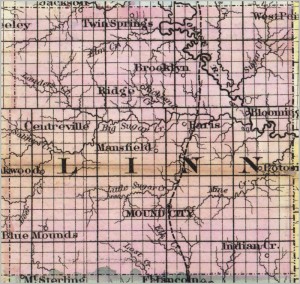Linn County, Kansas

- Formed: 1867
- County Population 1860: 6,336
- Civil War Engagements
-The Marias des Cygnes Massacre, May 19, 1858
-Battle of Paris, December 1, 1859
-Battle of Mine Creek, October 25, 1864
Image courtesy of Wichita State University Special Collections
Linn County, Kansas is located on the Missouri-Kansas border along the Marais des Cygnes (Marsh of the Swans) River. It contains many freshwater creeks, including the Middle, North Sugar, Big Sugar, Little Sugar, Deer, Lost, Goodrich, and Mine Creeks. The soil is very fertile and suitable for growing corn, flax, hay, wheat, and oats. The county area contained a Miami Reservation at the time of first settlement. The first non-Native American settlers were traders with the Miami and the nearby Osage reservation; their names were Girard and Edward Choteau.
During the 1850s, non-Native American settlers began came the area in abundance. Adam Pore, D.W. Cannon, and William H. Murray were vehemently pro-slavery, and became the pro-slavery leaders in the area when the debate over Kansas’ free or slave state status raged in the 1850s. James Osborne, William Montgomery, and William Park, adamantly against slavery, became the area’s Free State leaders.
Linn County was established by the “bogus” (fraudulently elected and therefore powerless) state legislature in 1855. It was not officially established until 1867. It was named after Lewis F. Linn, a senator from Missouri. The county seat was named Paris. There were many debates between the slave state and Free State factions over what representatives to send to the state’s constitutional conventions.
Battles in Linn County began even before the Civil War. On August 25, 1856, the Battle of Middle Creek occurred. Border ruffians from Missouri, hoping to make Kansas into a slave state, raided the county, harassing the Free State settlers. A battle between these ruffians, under the command of George W. Clarke, and Kansans from Fort Scott took place on May 30, 1856. The border ruffians were driven out of the state temporarily. The Marias des Cygnes Massacre took place on May 19, 1858. Border ruffians invaded Anderson County, Kansas, which was largely unprotected at the time. They captured eleven Free State men, intending to carry them back to Missouri. However, when they reached the Marais des Cygnes River in Linn County, they shot all eleven settlers and left them for dead. Five of them died, five were wounded, and one escaped unharmed. The murdered men were named William Stillwell, Patrick Ross, William Colpetzer, Michael Robinson, and John F. Campbell. In retaliation for the Marais des Cygnes Massacre, radical abolitionist John Brown, who had arrived in Kansas in the same year from Ohio, raided Missouri and freed eleven slaves for the eleven men shot.
On December 1, 1859, the Battle of Paris occurred. No actual fighting took place; the Battle of Paris was more a battle of will and words, though actual combat did almost occur. The county had voted in 1859 to move the county seat from Paris to Mound City. Not wanting to move the seat, citizens of Paris refused to move the county records. Forces from Mound City under Charles R. Jennison marched on Paris, stating there would be an attack if the records were not surrendered. In an attempt to keep the records, the Paris faction stated that they did not know where the records were. However, wanting to avoid a battle, the Parisians eventually surrendered the records to Mound City.
When the Civil War began in 1861, Linn County men enlisted in several military regiments. These included: Company E, 2nd Regiment Infantry, Companies D,E, and L, 6th Kansas Cavalry, Company H, 7th Kansas Cavalry, Company E, 10th Kansas Infantry, Company M, 15th Kansas Cavalry, Companies G and K, 12th Kansas Infantry, and the Kansas State Militia. Several commanders came from Linn County, including Robert B. Mitchell, who later became Brigadier-General, James Montgomery, and Charles R. Jennison. Major John T. Shoddy commanded a guerrilla regiment of jayhawkers. For most of the war, the county suffered from raids back and forth between Union and Confederate forces in Kansas and Missouri. On the October 24, 1864 Price crossed the state line into Kansas and that night encamped near a trading Post, in Linn County, on the Marais des Cygnes. The only major military battle that occurred in Linn County was during Sterling Price’s Raid, at The Battle of Mine Creek, on October 25, 1864. Price was defeated by Union troops from Fort Scott, and was driven back into Missouri.
After the Civil War’s end, residents successfully rebuilt their county. Linn County was officially (legally) established in 1867, along with several townships. These were: Centerville, Liberty, Lincoln, Valley, Stanton, Paris, Mound City, Scott, Sheridan, and Potosi. The oil and natural gas industry aided recovery.
 Browse all collections in Linn County
Browse all collections in Linn County
- Consulted:
- http://skyways.lib.ks.us/counties/LN/
- http://www.kshs.org/genealogists/places/counties.php?county=LN
- William G. Cutler, History of the State of Kansas (Chicago: A.T. Andreas, 1883). Accessed through:
- http://www.kancoll.org/books/cutler/linn/linn-co-p1.html
- http://www.fws.gov/refuges/profiles/index.cfm?id=64630
- http://linnco-ks.genweb.us
- Frank W. Blackman, Ed., Kansas: A Cyclopedia of State History, Embracing Events, Institutions, Industries, Counties, Cities, Towns, Prominent Persons, etc. (Standard Publishing Company, 1912) Accessed through:
- http://skyways.lib.ks.us/genweb/archives/1912/linn_county.html












